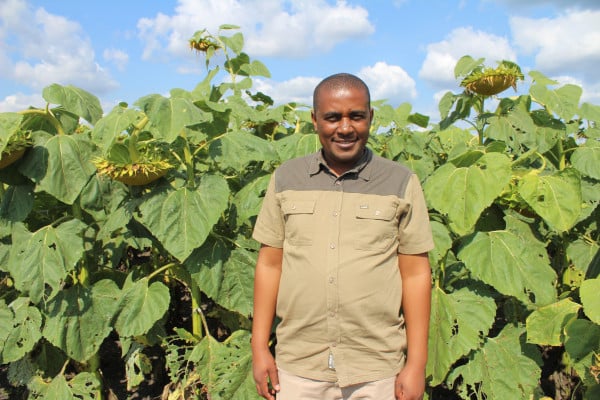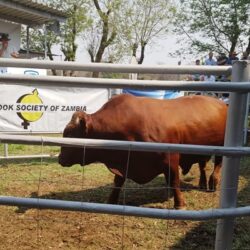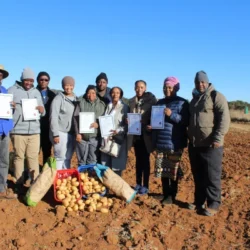Many farmers are specialists in their fields and Rudzani Sadiki, originally from Mokopane, Limpopo, was well on his way to becoming a poultry specialist when circumstances forced him into a completely different farming direction – farming oilseed crops. Not a man to allow change to put him off his stride, Rudzani adapted quickly and applied his mind to making a success of oilseed farming. He talks to Peter Mashala of African Farming about strategising and staying resilient.
Mokopane poultry farmer Rudzani Sadiki was happily supplying chickens to Mike’s Chickens in Polokwane as a contract grower, when the business collapsed, almost ruining Rudzani and many other contract growers who supplied the processor. The trouble for the poultry farmers began when the government bought Polokwane based Mike’s Chickens in a BEE deal that went badly wrong.
“Many of us saw it coming as we watched the new management begin to mismanage the business. We knew we had to make other plans,” says Rudzani. In 2016 he applied for, and was accepted as a grower for another farm. But the farm was at the other end of Limpopo, in Dwaalboom outside Thabazimbi, and it was a grain farm. Rudzani had to relocate and switch from commercial chicken production, producing 42 000 birds per cycle, to commercial grain production producing yellow maize, sorghum, wheat and sunflower on 1 000ha near Thabazimbi.
“It wasn’t an easy transition and I had to hit the ground running. But I think when you are a born farmer, nothing is impossible,” he says. Rudzani was born and raised in the Matshe village outside Makhado, previously Louis Trichardt, in Limpopo and started herding his grandmother’s cattle when he was a small child. By the time he was ten he had a few of his own cattle which his grandmother gave him. Although not conscious of it at the time, he was laying a foundation for his farming career.
“In high school, I wanted to be in the health industry to make my dad proud because he worked at the Chris Hani Baragwanath Hospital. I chose the mathematics and science stream to get into university so that I could study anything health related,” recalls Rudzani.
Then towards the end of his matric year he changed his mind and decided to study agriculture. “My dad was disappointed. His argument was that they had worked on farms in horrible conditions, and he didn’t believe a black person could be a successful farmer.”
Rudzani explains. Although Rudzani’s father did not approve of his son’s decision he continued to support him and in 2003 Rudzani registered for a National Diploma in Agricultural Management at Unisa. When he moved from Limpopo to Gauteng he sold his cattle as stock theft was rife in his area.
“My grandmother had passed away during my Grade 11 year and there was no one to look after the livestock,” he explains. When he was not studying, he attended as many agricultural workshops and seminars as possible. In 2006, while he was doing his experiential training at the Agricultural Research Council (ARC), the organisation held an event attended by the minister of agriculture and land affairs at the time, Thoko Didiza, and a few MECs, including Limpopo MEC, Dikeledi Magadzi.
“I approached the minister to share my story and vision, and, on the spot, she called the Limpopo MEC over,” says Rudzani. “Ms Magadzi gave me her contact details and from time to time I would call her with an update on my progress,” he recalls.
Rudzani’s big break came when he received a recapitalisation grant which meant he could buy much needed implements and machinery and reduce his dependency on contractors.
Rudzani continues to produce chickens on a smaller scale than he did previously. He produces 2 000 birds from four houses each with a capacity of 500 birds per cycle
GROWING POULTRY
Once he had completed his course, Rudzani moved back to Limpopo to start farming. His first opportunity came when a local farmer rented him a broiler house with the capacity for 7 000 birds. “At that time, there weren’t as many broiler producers as there are now and I did very well supplying the local informal market,” recalls Rudzani.
Then, through his conversations with the MEC, he got the chance to grow his business further. The department had spent a lot of money on a broiler project in Mokopane for a youth cooperative, which had collapsed. The MEC suggested to Rudzani that he take over the farm.
The takeover was facilitated and he was sent to Tzaneen for training. In October 2008 he moved to the fully automated, climate-controlled operation, running 42 000 chickens per cycle. The increased capacity meant he had to look for a contract.
“When I first approached Mike’s Chickens in Polokwane, they refused to give me a contract because of the bad experience they had with the previous management,” explains Rudzani. Unwilling to give up he went to see contract grower Ken Goelst.
“Ken agreed to act as my mentor, organised a meeting with Mike’s Chickens and convinced them to give me a chance,” he says. Rudzani delivered his first batch of chickens in January 2009.
MAKING THE CHANGE
When Mike’s Chickens, under new management, started experiencing problems, Rudzani knew he had to make another plan. He had already applied for a farm, but the department was no longer interested in funding another poultry farm. “I identified other farms in the area but they were either overpriced, or the deal fell flat due to delays, especially from the government’s side,” Rudzani says.
In 2016, he was finally approved for a farm of 1 285ha and he moved there in December of that year. The farm has 1 000ha of arable land; the remainder of the farm is used for grazing. Rudzani had 30 Nguni cattle when he moved and he took some of his poultry equipment as there were four small chicken houses each with a 500-bird capacity.
“I started producing broilers for the informal market in the nearby villages. It was challenging in the beginning but became easier as our clientele grew,” says Rudzani. The farm was geared for production and didn’t need much work before Rudzani could start farming. The only issue was a lack of fencing, which exposed his grain crops to wildlife.
“I had saved some money and got a contractor to plant my first crop on 500ha,” recalls Rudzani. He relied on neighbours for a few years to help with cultivation, planting and harvesting. And then his luck turned when he was approved for the recapitalisation grant in 2019. The Grain Farmer Development Association (GFADA), an initiative of the grain trusts, helped him draft a business plan that was approved and Rudzani was able to buy some equipment.
“I got two tractors, a six-row planter, a 1 000-litre boom sprayer, a 10t grain trailer, and a 1 000 litre diesel trailer. I put up a 300m2 shed and fenced the farm.” He had a problem with wildlife, especially kudu, eating his sunflower crop.
“I could lose up to 100ha to kudu,” he says. The recap funds covered 250ha of production and Rudzani funded the remaining hectares. There is currently 974ha planted to sunflower on the farm, which is supplied on contract. “We have grown only sunflowers for the past few seasons as it is currently a good time to be in sunflower production,” Rudzani says. Commodity prices influence his crop selection.
“When the prices are up, I hedge my sunflower price, and this season I have already committed 400t,” he explains. “But I am careful not to overcommit, because if something happens and I can’t produce the promised tonnage I have to buy in the difference from another farmer to meet my commitment.”
Rudzani says the Dwaalboom area is good for sunflower production. With an annual rainfall of 500mm, he gets dryland yields of 1.2t/ha. The predominantly heavy clay soil is fertile and farmers in the area don’t use fertiliser. “Applying fertiliser makes no difference to the yields,” he points out surprisingly. This is an economic advantage, especially now when fertiliser prices are going through the roof, says Rudzani. Planting starts in late November and continues until the end of February.
“You can push it to around the first week of March, but to be on the safe side planting should be done by 28 February.” Cultivation starts in October after the first rains. “We need at least 120mm before we start with land prep,” says Rudzani. He starts by tilling the land to kill all the weeds.
“We sometimes have to use round-up for persistent weeds before we plant,” he says. He uses Roundup Ready Pannar Seed cultivars, Pannar 7102 and 7160, which he says are the best performing cultivars for the area.
Sunflower yields dryland averages of 1.2 t/ha but can reach yields of 1.8 t/ha in a good year.
As part of a diversification strategy, Rudzani is building his livestock component with sheep and cattle.
PRECISION AND DIVERSITY
He practices precision farming for optimum production. Although the equipment is not cheap, Rudzani says it is worth the investment over time. “I know exactly how much seed is planted, and the planting depth, which helps me farm smarter and conserve resources.”
His plant population is 25 000 plants/ha. Provinces with higher rainfall can plant at 40 000 plants/ha but overpopulating leads to poor yields, he warns. He uses six-row and eight-row planters. “The eight-row planter can cover about 5ha/hour. When we are planting there is no time to stop, not even for lunch. If you stop for an hour’s lunch, you’ve lost 5ha that day.”
He staggers the planting to allow time lags between lands to spread risk. “For example, the lands I planted in December did not produce very well while those I planted from the end of January to the beginning of February are looking much better,” he says.
During the six years he has been on the farm, Rudzani has grown his Nguni herd from 30 to 130 breeding cows. However, he is in the process of switching to Bonsmara cattle and has already sold 90 Ngunis and bought in pregnant Bonsmara cows. He has also introduced Dorper sheep to the operation.
“I started with a trial of 10 sheep about two years ago and it has gone very well,” he says. “I wanted to see how the sheep did in this environment. I believe it’s important to do trials before making any major changes or adding commodities to your operation,” he explains. “This gives you some insight into factors you may not have anticipated and allows you to adjust your approach before increasing the scale,” he adds. He currently has about 30 breeding ewes and a ram and he plans to increase those numbers.




